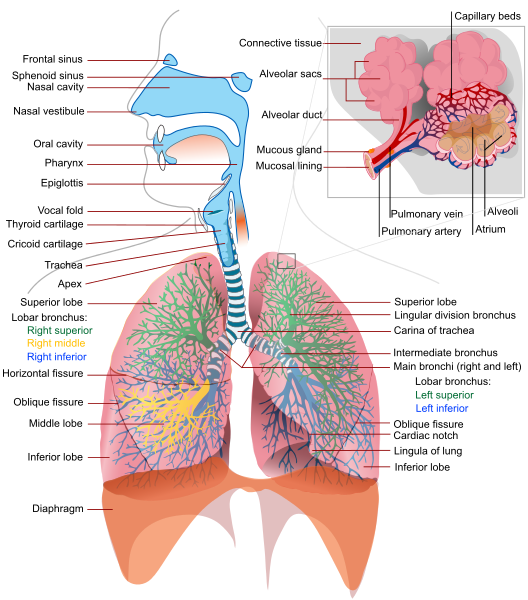10.2 Respiratory Basic Concepts
Open Resources for Nursing (Open RN)
The main function of our respiratory system is to provide the body with a constant supply of oxygen and to remove carbon dioxide. To achieve these functions, muscles and structures of the thorax create the mechanical movement of air into and out of the lungs called ventilation. Respiration includes ventilation and gas exchange at the alveolar level where blood is oxygenated and carbon dioxide is removed. When completing a respiratory assessment, it is important for the nurse to understand the external and internal structures involved with respiration and ventilation. See Figure 10.1[1] for an illustration of the upper and lower respiratory system structures. Notice the lobular division of the lung structures and the bronchial tree.

For more information on basic oxygenation concepts, visit the “Oxygen Therapy” chapter of this book.
For more information about applying the nursing process to patients experiencing decreased oxygenation, visit the “Oxygenation” chapter in Open RN Nursing Fundamentals.
For a detailed review of the respiratory system, common respiratory disorders, and related medications, visit the “Respiratory” chapter of the Open RN Nursing Pharmacology textbook. Specific sections of this chapter include the following:
Video Reviews of the Anatomy of the Respiratory System and Breathing Mechanics:
Respiratory System Anatomy[2]
Respiratory System: Breathing Mechanics[3]
- “Respiratory_system_complete_en.png” by British Columbia Institute of Technology is licensed under CC BY 4.0. Access for free at https://opentextbc.ca/clinicalskills/chapter/2-5-focussed-respiratory-assessment/ ↵
- Forciea, B. (2015, May 13). Respiratory system anatomy (v2.0). [Video]. YouTube. All rights reserved. Video used with permission. https://youtu.be/aqTwrdMS6CE ↵
- Forciea, B. (2015, May 12). Anatomy and physiology: Respiratory system: Breathing mechanics (v2.0). [Video]. YouTube. All rights reserved. Video used with permission. https://youtu.be/X-J5Xgg3l6s ↵
The mechanical movement of air into and out of the lungs.
Includes ventilation and gas exchange at the alveolar level where blood is oxygenated and carbon dioxide is removed.

